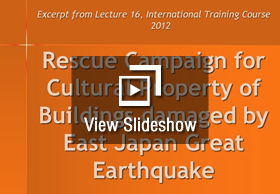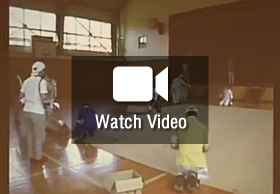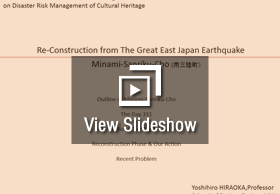

This module focuses on the larger context of post disaster recovery, the local, regional and international networks which facilitate recovery, how funds can be raised, and the various processes involved in planning for both a short term and a long term recovery. It takes into account the post-disaster assessment of damage highlighted in the previous module and highlights potential interventions once the damage has been fully assessed.
1. Long-term measures to ensure that the rehabilitation process is initiated at the quickly and that future disaster risks are minimised as much as possible.
2. Raising resources, both financial and human, through the larger institutional network at local, regional, national and even international levels as necessary.
3. Understanding the significance of the tangible and intangible values associated with cultural heritage and using it as an asset for recovery. Preserving the heritage value of the sites, following a minimal intervention policy as far as possible and including local stakeholders in this process.
4. Reviewing site management as well as local and regional planning and management systems.
5. Raising community awareness and participation in the recovery process.







The instructor should introduce the short term and long term prioritisation of recovery processes. This lecture may be specific to a certain context and scenario relevant to the country/region. It may be a combination of a presentation, which gives a broader background of heritage and disaster management networks internationally, regionally and nationally that can be utilised for recovery, along with a more focused lecture supplemented by secondary case studies.
The thematic lectures could either be combined with the core lectures of this section or extend across the entire module using specific case studies relevant to the local context to illustrate various stages of the post disaster recovery process.
Experience of the Great Hanshin‐Awaji Earthquake (PART II): Actions taken during Restoration Period after the Hanshin Awaji Earthquake, International Training Course, 2011
Instructor: Yasumichi Murakami
Duration: 80 minutes
Read More...


Visits to different sites could also be used to illustrate the comparison between short-term post disaster recovery actions and a sustained long-term plan. The 2012 International Training Course organised by R-DMUCH highlighted both long and short term strategies to the participants through the case studies of the Hanshin Awaji Earthquake of 1995 and the more recent earthquake and tsunami in the Tohoku region of northeastern Japan in 2011.
Planning for disaster recovery of cultural heritage
A workshop may be designed and organised to supplement the knowledge and understanding of the participants for the immediate, short term and long term considerations for post disaster recovery for their respective case study sites and plans for recovery. The participants could work in teams. An imaginary disaster scenario may be presented to them to use as a reference. Potentially, this could be linked to previous workshops involving risk analysis and mitigation. Based on a detailed worksheet, they may be asked to prioritise actions and activities for recovery, address resource usage and identify potential networks and agencies which may be engaged for different activities.
Planning and Design Interventions for Rehabilitation of Damaged Traditional Settlements
Site: Minamisanriku-cho
Site visits and Workshops, International Training Course organised by R-DMUCH in 2012 and 2014
Instructor: Rohit Jigyasu, Naoko Itaya
Read More...

Site: Tao Ping Qiang, China
Participant: Wang Yu, International Training Course, 2011
Read More...


This section focuses on the various approaches and methodologies for preventing and mitigating disaster risks to cultural heritage. This generally involves one or more of the following approaches
Key aspects to be introduced and discussed
A policy of minimal intervention should be retained as much as possible; the values, authenticity and integrity of the cultural heritage should be considered while deciding appropriate mitigation measures. Reviews should be done periodically to the disaster risk management strategy to prevent any unintended impact of risk-reduction activities.
Thematic Lectures with Secondary Case Studies
The thematic lectures could either be combined with the core lectures of this section or extend across the entire module using specific case studies relevant to the local context to illustrate various stages of the post disaster recovery process.
Site visits
Visits to different sites could also be used to illustrate the comparison between short-term post disaster recovery actions and a sustained long-term plan. The 2012 International Training Course organised by R-DMUCH highlighted both long and short term strategies to the participants through the case studies of the Hanshin Awaji Earthquake of 1995 and the more recent earthquake and tsunami in the Tohoku region of northeastern Japan in 2011.
Thematic Workshops
Planning for disaster recovery of cultural heritage
A workshop may be designed and organised to supplement the knowledge and understanding of the participants for the immediate, short term and long term considerations for post disaster recovery for their respective case study sites and plans for recovery. The participants could work in teams. An imaginary disaster scenario may be presented to them to use as a reference. Potentially, this could be linked to previous workshops involving risk analysis and mitigation. Based on a detailed worksheet, they may be asked to prioritise actions and activities for recovery, address resource usage and identify potential networks and agencies which may be engaged for different activities.
A site visit, which may be linked to a workshop as part of a primary case study for this module, may be organised for participants to engage them in the damage assessment process. For instance, participants in 2011 International Training Course organised by R-DMUCH were given a series of lectures on the Hanshin Awaji Earthquake that was linked to a site visit the following day.
 |
Introduction to the post disaster recovery process for cultural heritage indicating the role of assessment and right, a sample format for recording post disaster damage to cultural assets at an urban scale (Yasumichi Murakami)
|
Experience of the Great Hanshin‐Awaji Earthquake (PART II): Actions taken during Restoration Period after the Hanshin Awaji Earthquake, International Training Course, 2011
Instructor: Yasumichi Murakami | Duration: 80 minutes
This lecture uses the example of the Great Hanshin Awaji Earthquake and its impact on heritage in the region. This is a continuation of the lecture given in the previous sub-module (Damage Assessment) and highlights the actions that were undertaken by local and national authorities
During this section of the lectures, the instructor focused on the sequence of actions that were undertaken during the restoration period after the earthquake.
1) Initial Period: Need for surveys of Historic and Cultural Resources
In this phase a system to survey devastated area through cooperation between industry, government, academia, and private sectors was established. It also revealed the importance of prior preparation of a location map for effective survey.
2) Recovery Period: Long Term Changes in Management of Cultural Properties
i) Funding
In post disaster recovery of cultural properties, a perspective of 'community property' was first introduced in Japan. Undesignated cultural properties (historic buildings, etc.) were supported through efforts of the private sector. For repairing designated cultural properties and undesignated cultural property, a budget for almost 400 properties in total was reserved from the restoration fund. In addition the Foundation for Cultural Heritage and art Research raised fund throughout Japan with the intention of building nation-wide assistance in line with increasing the awareness of preservation of cultural properties.
ii) Human Resources
Shortage of human resources revealed the defect of the cultural property preservation strategy in Japan, which only targeted designated cultural properties.
Planning and Design Interventions for Rehabilitation of Damaged Traditional Settlements
Site: Minamisanriku-cho
Site visits and Workshops, International Training Course organised by R-DMUCH in 2012 and 2014
Instructor: Rohit Jigyasu, Naoko Itaya
Participants visited the districts of Minamisanriku –cho that had been extensively damaged due to the Great East Japan Earthquake and Tsunami in 2011. Based on their observations on site, they were asked to conceptualise planning and design interventions for rehabilitation of the settlements damaged as a result of the disaster.
The workshop focused on formulating policy, planning and design strategies for integrating cultural heritage in post disaster recovery of Shizugawa Settlement in Minamisanriku-cho district of Tohoku. Through lectures and site visits, the participants were introduced to the different aspects of Minamisanriku-cho.
The participants undertook field visits to the Tsunami devastated Shizugawa settlement. During this visit they observed some of the surviving traces of the erstwhile settlement and also visited some of the neighboring shrines that survived the disaster. They also visited surroundings of the three areas for relocation of this settlement. The participants were divided into two groups and each group was asked to consider the following:
The proposals were presented through posters and presentations.
Recovery Plan for a Case Study Site
In cases where the organisers do not have access to a primary case study area where disaster has taken place and recovery and rehabilitation is underway then the primary case study site used for previous workshops or one of the participants case study sites may be chosen to prepare a recovery plan for one of the scenarios developed by the participants in Module 2.
Format based on the International Training Course series.
Participants may be asked to consider the following:
Sample worksheet for prioritising recovery activities
Priority Level |
Recovery Activities |
Actors to be engaged |
Human Resources Needed |
Financial resources needed |
Immediate |
|
|||
Short Term |
|
|
||
Long term |
|
|
Site: Tao Ping Qiang, China
Participant: Wang Yu, International Training Course, 2011
Background
The village of Taoping is located in the Sichuan province of China and dates back over 3000 years to the Shang Dynasty. It has a unique defense and underground water system as well as outstanding design and construction skills responding to the undulating topography.
The participant analysed that the village was vulnerable to earthquakes, floods and landslides as well as fire based on historic data and topographical maps. He went on to identify various vulnerabilities to the site and its built fabric. Furthermore, he identified the various management systems in place for disaster risk management in the area. After imagining various disaster scenarios in the village, the participant outlined a detailed process of recovery, illustrated below.
